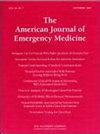Epidemiology of heart failure presentations to United States emergency departments from 2016 to 2023
IF 2.7
3区 医学
Q1 EMERGENCY MEDICINE
引用次数: 0
Abstract
Introduction
Heart failure (HF) is a common condition prompting presentation to the Emergency Department (ED) and is associated with significant morbidity and mortality. However, there is limited recent large-scale, robust data available on the admission rates, evaluation, and treatment of HF in the ED setting.
Methods
This was a cross-sectional study of ED presentations for HF from 1/1/2016 to 12/31/2023 using the Epic Cosmos database. All ED visits with ICD-10 codes corresponding to acute HF were included. We excluded congenital heart disease and isolated right-sided HF. Outcomes included percentage of total ED visits, admission rates, troponin, B-type natriuretic peptide (BNP), chest radiography, and diuretic and nitroglycerin medication administration. Subgroup analyses of medications were performed by medication and route of administration (transdermal, sublingual/oral, and intravenous).
Results
Out of 190,694,752 ED encounters, 2,626,011 (1.4 %) visits were due to acute HF. Of these, 1,897,369 (72.3 %) were admitted to the hospital. The majority of patients had a troponin (90.3 %), BNP (91.1 %), and chest radiograph (89.5 %) ordered. 82.5 % received intravenous diuresis, while 46.2 % received oral diuresis. The most common diuretic was furosemide (78.4 % intravenous, 32.5 % oral), followed by bumetanide (9.5 % intravenous, 7.1 % oral), and torsemide (0 % intravenous, 8.1 % oral). Nitroglycerin was given in 26.0 %, with the most common route being sublingual/oral (16.6 %), followed by transdermal (9.2 %) and intravenous (3.5 %).
Conclusion
HF represents a common reason for ED presentation, with the majority of patients being admitted. All patients received diuresis in the ED, with the majority receiving intravenous diuresis with furosemide. Approximately one-quarter received nitroglycerin with the sublingual/oral route being most common. These findings can help inform health policy initiatives, including admission decisions and evidence-based medication administration.
2016 年至 2023 年美国急诊科心力衰竭病例流行病学。
简介心力衰竭(HF)是急诊科(ED)的常见病,发病率和死亡率都很高。然而,近期有关急诊科心力衰竭的入院率、评估和治疗的大规模可靠数据非常有限:这是一项横断面研究,使用 Epic Cosmos 数据库对 2016 年 1 月 1 日至 2023 年 12 月 31 日期间因心房颤动而到急诊室就诊的患者进行研究。研究纳入了所有与急性心房颤动相对应的 ICD-10 编码的急诊室就诊病例。我们排除了先天性心脏病和孤立的右侧心房颤动。研究结果包括 ED 就诊总人数百分比、入院率、肌钙蛋白、B 型钠尿肽 (BNP)、胸部放射线检查以及利尿剂和硝酸甘油用药情况。按药物和给药途径(透皮、舌下/口服和静脉注射)对药物进行了分组分析:在190,694,752次急诊就诊中,有2,626,011次(1.4%)因急性高血压就诊。其中,1,897,369 人(72.3%)入院治疗。大多数患者接受了肌钙蛋白(90.3%)、BNP(91.1%)和胸片检查(89.5%)。82.5%的患者接受了静脉利尿,46.2%的患者接受了口服利尿。最常用的利尿剂是呋塞米(78.4% 静脉注射,32.5% 口服),其次是布美他尼(9.5% 静脉注射,7.1% 口服)和托昔米(0% 静脉注射,8.1% 口服)。使用硝酸甘油的比例为 26.0%,最常见的途径是舌下/口服(16.6%),其次是透皮(9.2%)和静脉注射(3.5%):结论:心房颤动是急诊科的常见病因,大多数患者需要住院治疗。所有患者都在急诊室接受了利尿治疗,其中大多数人接受了呋塞米静脉利尿治疗。约四分之一的患者接受了硝酸甘油治疗,其中以舌下/口服途径最为常见。这些发现有助于为卫生政策措施提供信息,包括入院决定和循证用药。
本文章由计算机程序翻译,如有差异,请以英文原文为准。
求助全文
约1分钟内获得全文
求助全文
来源期刊
CiteScore
6.00
自引率
5.60%
发文量
730
审稿时长
42 days
期刊介绍:
A distinctive blend of practicality and scholarliness makes the American Journal of Emergency Medicine a key source for information on emergency medical care. Covering all activities concerned with emergency medicine, it is the journal to turn to for information to help increase the ability to understand, recognize and treat emergency conditions. Issues contain clinical articles, case reports, review articles, editorials, international notes, book reviews and more.

 求助内容:
求助内容: 应助结果提醒方式:
应助结果提醒方式:


